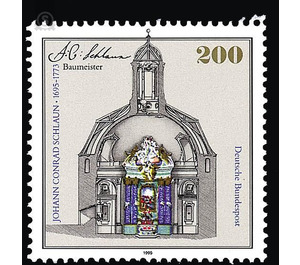300th birthday of Johann Conrad Schlaun - Germany / Federal Republic of Germany 1995 - 200 Pfennig
Theme: Architecture
| Country | Germany / Federal Republic of Germany |
| Issue Date | 1995 |
| Face Value | 200.00 |
| Color | grey |
| Perforation | K 13 1/4 |
| Printing Type | Multicolor offset printing |
| Stamp Type | Postage stamp |
| Item Type | Stamp |
| Chronological Issue Number | 1660 |
| Chronological Chapter | GER-BRD |
| SID | 585538 |
| In 33 Wishlists | |
Johann Conrad Schlaun, born on June 5, 1695 in Nörde near Warburg, was a master builder in war and peace. As an architect and engineer, as chief engineer and general of the Cologne Elector and bishop of Münster, he has made a career as a master builder of the rich city and country nobility in Kurköln and in the prince bishopric of Münster, leaving an enormous range of architectural creations. He has built almost "everything": from the garden shed to the Residenzschloss, from the farm to the pleasure house, from the chapel to the monastery, from the gun to the fortress. Like no other, he has shaped the country's architecture to the present day. His "grand goût" transformed into red bricks and yellow sandstone is still noticeable in Münster, his most important buildings are missing in no architectural history: the Erbdrostenhof, city palace for the Heidenreich Heidenreich Freiherr von Droste to Vischering, an ingenious spatial solution that is also significant in urban planning Clemenskirche, an electoral central building, which made the papal Rome present in Münster, at the same time Northern Germany's most important baroque church, his living and studio house in the French style and house Rüschhaus - an extraordinarily attractive combination of pleasure house and manor. His plans for the hunting lodge Clemenswerth in Emsland, the builder was the Wittelsbach archbishop, and for his residence Brühl have produced unique architectures. Schlaun died in 1773 in Münster, when he had built the shell of the Residenzschlosses for the Cologne Elector. (Text: Westphalian State Museum of Art and Cultural History, Münster)


